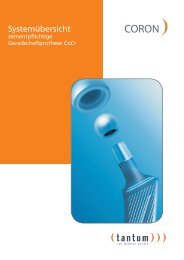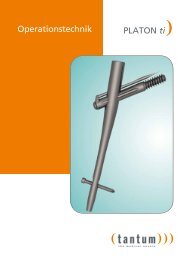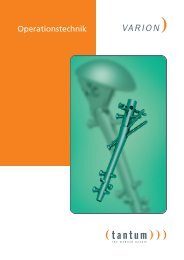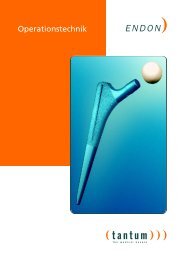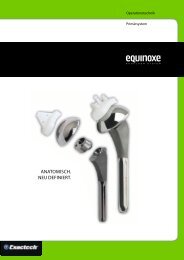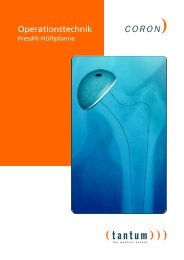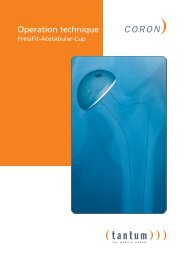PLATON-Locking-Nail-System - tantum AG
PLATON-Locking-Nail-System - tantum AG
PLATON-Locking-Nail-System - tantum AG
Create successful ePaper yourself
Turn your PDF publications into a flip-book with our unique Google optimized e-Paper software.
<strong>PLATON</strong> OR manual<br />
Fig.1<br />
Fig. 2<br />
Fig.3<br />
A<br />
B<br />
<strong>tantum</strong> · OR manual <strong>PLATON</strong><br />
1. Preoperative Planning<br />
In order to place the <strong>PLATON</strong>-S-<strong>Nail</strong> correctly, a preoperative<br />
determination of the neck-shaft angle is helpful.<br />
With major dislocation of the fragments, an x-ray<br />
of the unaffected extremity can be useful. The angle<br />
measured in the standard x-ray AP view is to be reduced<br />
by 5-10°due to the femur neck anteversion.<br />
2. Patient Positioning<br />
The patient is positioned supine on the extensiontable<br />
and the injured extremity is positioned in a foot<br />
extension and held in 5°inward rotation. The patella<br />
should be horizontal or rotated slightly inward.<br />
Rotating the C-arm enables a medial-lateral as well as<br />
an anterior-posterior view of the trochanteric area.<br />
Therefore, the uninjured leg should be abducted as<br />
much as possible (Fig. 1+2).<br />
3. Reduction of the fracture<br />
Prior to the operation, reduction of the fracture has to<br />
be conducted in an anatomical exact fashion. If this is<br />
not possible with instable or extremely dislocated<br />
fractures, the fracture (with slight extension of the<br />
incision distally) has to be reduced openly and eventually<br />
fixated with forceps.<br />
4. Entry portal of the <strong>PLATON</strong>-S-<strong>Nail</strong><br />
The palpable proximal end of the greater trochanter<br />
is marked on the skin. Cranially, an approx. 5cm long<br />
skin incision parallel to the axis of the gluteus medius<br />
muscle in direction of the iliac crest is made. After<br />
splitting the iliotibial tractus, the tip of the greater<br />
trochanter (Fig. 3. A) is exposed by blunt preparation<br />
of the gluteus medius muscle. Absolute care must be<br />
taken when exposing the femur that it is in line with<br />
its long axis. Only with extreme antecurvation of the<br />
femur in the proximal area should the entry portal be<br />
positioned slightly more dorsally (Fig. 3. B).<br />
7



